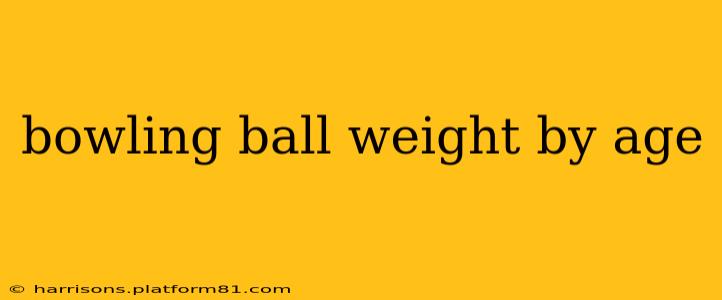Choosing the right bowling ball weight is crucial for optimal performance and injury prevention. It's not simply about picking the heaviest ball you can lift; it's about finding the weight that allows you to generate consistent power and accuracy without straining your muscles or joints. This guide will help you determine the appropriate bowling ball weight based on age and other important factors.
What Determines the Ideal Bowling Ball Weight?
Before diving into age-specific recommendations, it's important to understand that age isn't the sole determinant of bowling ball weight. Several factors influence this decision:
- Strength: Your overall upper body strength directly impacts your ability to handle heavier balls. Stronger bowlers can generally manage heavier weights, while those with less strength should opt for lighter ones.
- Bowling Style: Your bowling technique plays a significant role. Two-handed bowlers often use heavier balls than one-handed bowlers, as they generate more power through their entire body.
- Physical Condition: Pre-existing injuries, arthritis, or other physical limitations can impact your ability to comfortably handle a heavier ball. Prioritizing comfort and injury prevention is paramount.
- Ball Speed: The speed at which you release the ball influences the ideal weight. Faster bowlers may benefit from slightly lighter balls to maintain control.
Bowling Ball Weight by Age Group: General Guidelines
While precise weight recommendations are difficult without considering individual factors, we can provide general guidelines based on age groups. Remember, these are starting points – you may need to adjust based on your individual strength, style, and comfort level.
Children (Under 12):
Children should start with significantly lighter balls, typically ranging from 6 to 12 pounds. The focus should be on developing proper technique and having fun, not on generating maximum power. As they grow stronger and their skills improve, they can gradually increase the weight.
Teenagers (13-17):
Teenagers can handle heavier balls, typically in the range of 12 to 15 pounds. However, it’s vital to monitor their progress and ensure they don't experience strain or discomfort. Proper coaching can guide them to choose the appropriate weight.
Adults (18-50):
Adult bowlers generally use weights ranging from 12 to 16 pounds, but this is highly dependent on individual strength and style. Many adult bowlers find weights between 14 and 15 pounds ideal.
Seniors (50+):
Senior bowlers often prefer lighter weights, typically between 10 and 14 pounds. This is due to potential changes in strength and flexibility as we age. Prioritizing comfort and injury prevention is crucial for this age group.
How to Determine the Right Weight for You: A Practical Approach
The best way to determine the ideal bowling ball weight is through hands-on experimentation.
- Try Different Weights: Visit your local bowling alley or pro shop and try bowling with a range of weights. Start with a lighter ball and gradually increase the weight until you find one that feels comfortable and allows for consistent accuracy and power.
- Listen to Your Body: If you feel any strain, pain, or discomfort in your shoulder, elbow, wrist, or back, immediately reduce the weight. Ignoring pain can lead to serious injuries.
- Consult a Professional: A bowling pro shop professional can help you assess your strength, style, and skill level to recommend an appropriate weight range. They can also help you choose a ball that suits your bowling style and preferences.
Frequently Asked Questions (FAQ)
What happens if I use a bowling ball that's too heavy?
Using a bowling ball that's too heavy can lead to several problems, including:
- Muscle strain: Overexerting your muscles can lead to pain, soreness, and potentially serious injuries.
- Inconsistent throws: You may struggle to control the ball, resulting in inconsistent accuracy and lower scores.
- Injury risk: Repeated strain on your joints and muscles can lead to long-term injuries.
What happens if I use a bowling ball that's too light?
While less risky than using a ball that's too heavy, using a ball that's too light can also be problematic:
- Lack of power: You may not be able to generate enough power to knock down pins effectively.
- Difficulty controlling the ball: A lighter ball can be harder to control, especially at higher speeds.
- Poor accuracy: Your shots may be less accurate due to the lack of power and control.
Can I change my bowling ball weight as I get older?
Absolutely! As your strength and physical condition change, it’s perfectly normal to adjust your bowling ball weight accordingly. Prioritizing comfort and injury prevention is key at all ages. Don’t hesitate to try lighter weights as you age or if you experience any discomfort.
How often should I check if my bowling ball weight is still appropriate?
It's a good idea to reassess your bowling ball weight at least once a year, or more frequently if you notice any changes in your strength, physical condition, or bowling style. Regular evaluation helps to ensure you're bowling safely and effectively.
By carefully considering your strength, age, style, and comfort level, you can choose a bowling ball weight that allows you to enjoy the game safely and effectively. Remember, it's not about the weight of the ball, but about the control and consistency you can achieve with it.
